tyre pressure FIAT DUCATO 2013 Owner handbook (in English)
[x] Cancel search | Manufacturer: FIAT, Model Year: 2013, Model line: DUCATO, Model: FIAT DUCATO 2013Pages: 287, PDF Size: 4.5 MB
Page 114 of 287
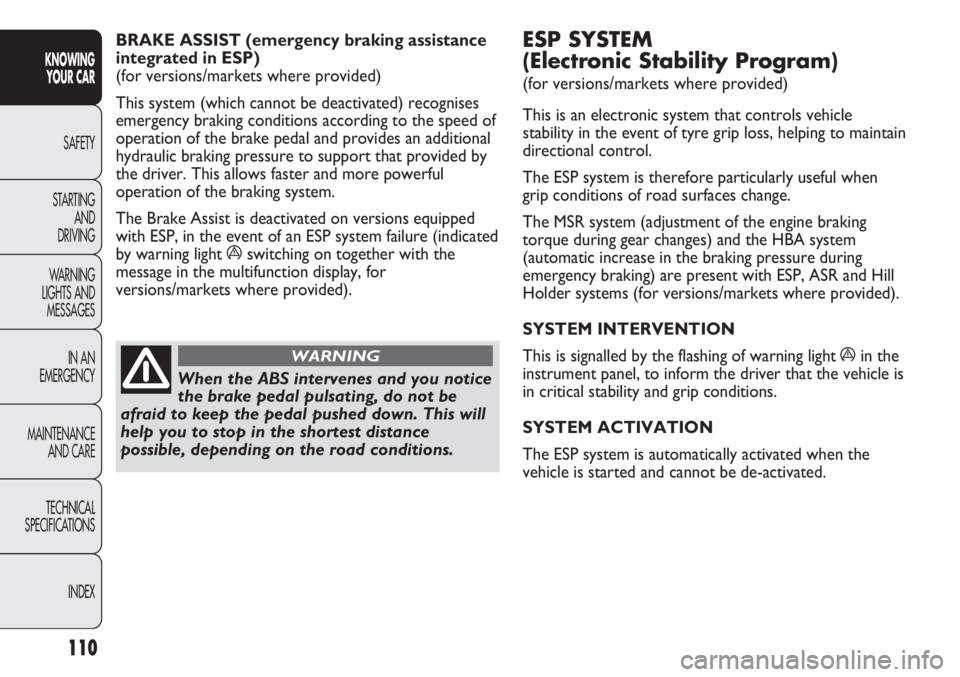
110
KNOWING
YOUR CAR
SAFETY
STARTING
AND
DRIVING
WARNING
LIGHTS AND
MESSAGES
IN AN
EMERGENCY
MAINTENANCE
AND CARE
TECHNICAL
SPECIFICATIONS
INDEX
ESP SYSTEM
(Electronic Stability Program)
(for versions/markets where provided)
This is an electronic system that controls vehicle
stability in the event of tyre grip loss, helping to maintain
directional control.
The ESP system is therefore particularly useful when
grip conditions of road surfaces change.
The MSR system (adjustment of the engine braking
torque during gear changes) and the HBA system
(automatic increase in the braking pressure during
emergency braking) are present with ESP, ASR and Hill
Holder systems (for versions/markets where provided).
SYSTEM INTERVENTION
This is signalled by the flashing of warning light
áin the
instrument panel, to inform the driver that the vehicle is
in critical stability and grip conditions.
SYSTEM ACTIVATION
The ESP system is automatically activated when the
vehicle is started and cannot be de-activated. BRAKE ASSIST (emergency braking assistance
integrated in ESP)
(for versions/markets where provided)
This system (which cannot be deactivated) recognises
emergency braking conditions according to the speed of
operation of the brake pedal and provides an additional
hydraulic braking pressure to support that provided by
the driver. This allows faster and more powerful
operation of the braking system.
The Brake Assist is deactivated on versions equipped
with ESP, in the event of an ESP system failure (indicated
by warning light
áswitching on together with the
message in the multifunction display, for
versions/markets where provided).
When the ABS intervenes and you notice
the brake pedal pulsating, do not be
afraid to keep the pedal pushed down. This will
help you to stop in the shortest distance
possible, depending on the road conditions.
WARNING
Page 115 of 287
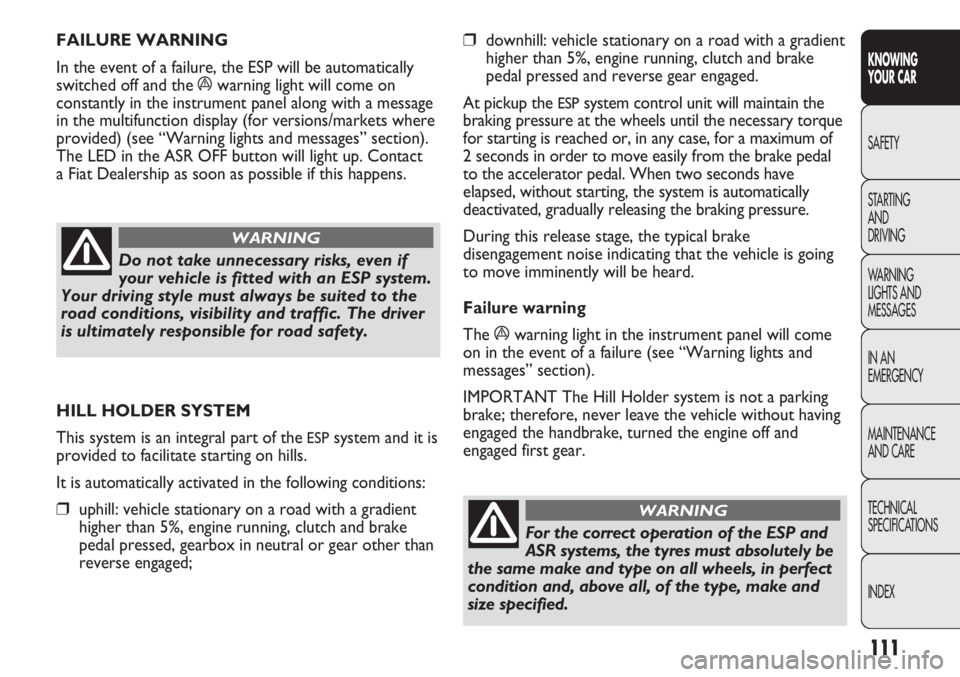
111
KNOWING
YOUR CAR
SAFETY
STARTING
AND
DRIVING
WARNING
LIGHTS AND
MESSAGES
IN AN
EMERGENCY
MAINTENANCE
AND CARE
TECHNICAL
SPECIFICATIONS
INDEX
❒downhill: vehicle stationary on a road with a gradient
higher than 5%, engine running, clutch and brake
pedal pressed and reverse gear engaged.
At pickup the
ESPsystem control unit will maintain the
braking pressure at the wheels until the necessary torque
for starting is reached or, in any case, for a maximum of
2 seconds in order to move easily from the brake pedal
to the accelerator pedal. When two seconds have
elapsed, without starting, the system is automatically
deactivated, gradually releasing the braking pressure.
During this release stage, the typical brake
disengagement noise indicating that the vehicle is going
to move imminently will be heard.
Failure warning
The
áwarning light in the instrument panel will come
on in the event of a failure (see “Warning lights and
messages” section).
IMPORTANT The Hill Holder system is not a parking
brake; therefore, never leave the vehicle without having
engaged the handbrake, turned the engine off and
engaged first gear. FAILURE WARNING
In the event of a failure, the ESP will be automatically
switched off and the áwarning light will come on
constantly in the instrument panel along with a message
in the multifunction display (for versions/markets where
provided) (see “Warning lights and messages” section).
The LED in the ASR OFF button will light up. Contact
a Fiat Dealership as soon as possible if this happens.
Do not take unnecessary risks, even if
your vehicle is fitted with an ESP system.
Your driving style must always be suited to the
road conditions, visibility and traffic. The driver
is ultimately responsible for road safety.
WARNING
HILL HOLDER SYSTEM
This system is an integral part of the
ESPsystem and it is
provided to facilitate starting on hills.
It is automatically activated in the following conditions:
❒uphill: vehicle stationary on a road with a gradient
higher than 5%, engine running, clutch and brake
pedal pressed, gearbox in neutral or gear other than
reverse engaged;
For the correct operation of the ESP and
ASR systems, the tyres must absolutely be
the same make and type on all wheels, in perfect
condition and, above all, of the type, make and
size specified.
WARNING
Page 152 of 287
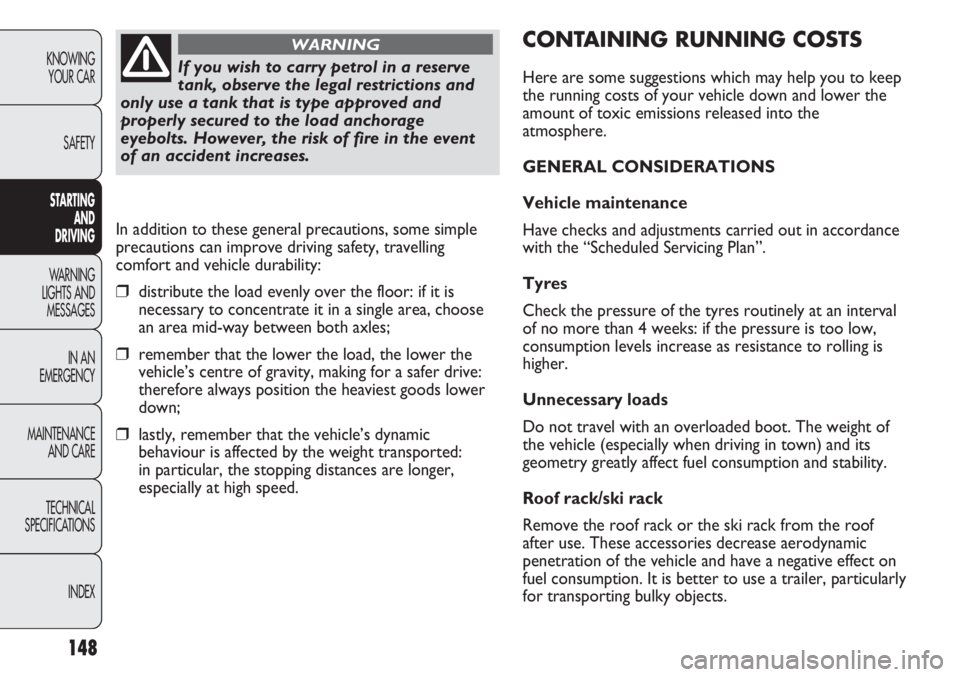
148
KNOWING
YOUR CAR
SAFETY
STARTING
AND
DRIVING
WARNING
LIGHTS AND
MESSAGES
IN AN
EMERGENCY
MAINTENANCE
AND CARE
TECHNICAL
SPECIFICATIONS
INDEX
CONTAINING RUNNING COSTS
Here are some suggestions which may help you to keep
the running costs of your vehicle down and lower the
amount of toxic emissions released into the
atmosphere.
GENERAL CONSIDERATIONS
Vehicle maintenance
Have checks and adjustments carried out in accordance
with the “Scheduled Servicing Plan”.
Tyres
Check the pressure of the tyres routinely at an interval
of no more than 4 weeks: if the pressure is too low,
consumption levels increase as resistance to rolling is
higher.
Unnecessary loads
Do not travel with an overloaded boot. The weight of
the vehicle (especially when driving in town) and its
geometry greatly affect fuel consumption and stability.
Roof rack/ski rack
Remove the roof rack or the ski rack from the roof
after use. These accessories decrease aerodynamic
penetration of the vehicle and have a negative effect on
fuel consumption. It is better to use a trailer, particularly
for transporting bulky objects. In addition to these general precautions, some simple
precautions can improve driving safety, travelling
comfort and vehicle durability:
❒distribute the load evenly over the floor: if it is
necessary to concentrate it in a single area, choose
an area mid-way between both axles;
❒remember that the lower the load, the lower the
vehicle’s centre of gravity, making for a safer drive:
therefore always position the heaviest goods lower
down;
❒lastly, remember that the vehicle’s dynamic
behaviour is affected by the weight transported:
in particular, the stopping distances are longer,
especially at high speed.
If you wish to carry petrol in a reserve
tank, observe the legal restrictions and
only use a tank that is type approved and
properly secured to the load anchorage
eyebolts. However, the risk of fire in the event
of an accident increases.
WARNING
Page 160 of 287
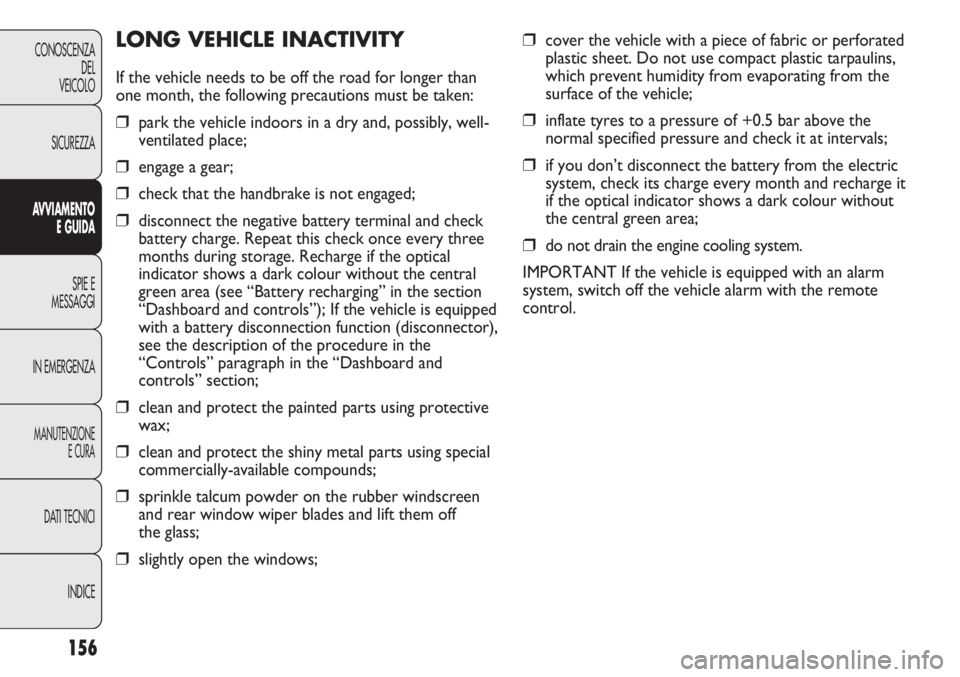
❒cover the vehicle with a piece of fabric or perforated
plastic sheet. Do not use compact plastic tarpaulins,
which prevent humidity from evaporating from the
surface of the vehicle;
❒inflate tyres to a pressure of +0.5 bar above the
normal specified pressure and check it at intervals;
❒if you don’t disconnect the battery from the electric
system, check its charge every month and recharge it
if the optical indicator shows a dark colour without
the central green area;
❒do not drain the engine cooling system.
IMPORTANT If the vehicle is equipped with an alarm
system, switch off the vehicle alarm with the remote
control.
LONG VEHICLE INACTIVITY
If the vehicle needs to be off the road for longer than
one month, the following precautions must be taken:
❒park the vehicle indoors in a dry and, possibly, well-
ventilated place;
❒engage a gear;
❒check that the handbrake is not engaged;
❒disconnect the negative battery terminal and check
battery charge. Repeat this check once every three
months during storage. Recharge if the optical
indicator shows a dark colour without the central
green area (see “Battery recharging” in the section
“Dashboard and controls”); If the vehicle is equipped
with a battery disconnection function (disconnector),
see the description of the procedure in the
“Controls” paragraph in the “Dashboard and
controls” section;
❒clean and protect the painted parts using protective
wax;
❒clean and protect the shiny metal parts using special
commercially-available compounds;
❒sprinkle talcum powder on the rubber windscreen
and rear window wiper blades and lift them off
the glass;
❒slightly open the windows;
156
CONOSCENZA
DEL
VEICOLO
SICUREZZA
AVVIAMENTO
E GUIDA
SPIE E
MESSAGGI
IN EMERGENZA
MANUTENZIONE
E CURA
DATI TECNICI
INDICE
Page 175 of 287
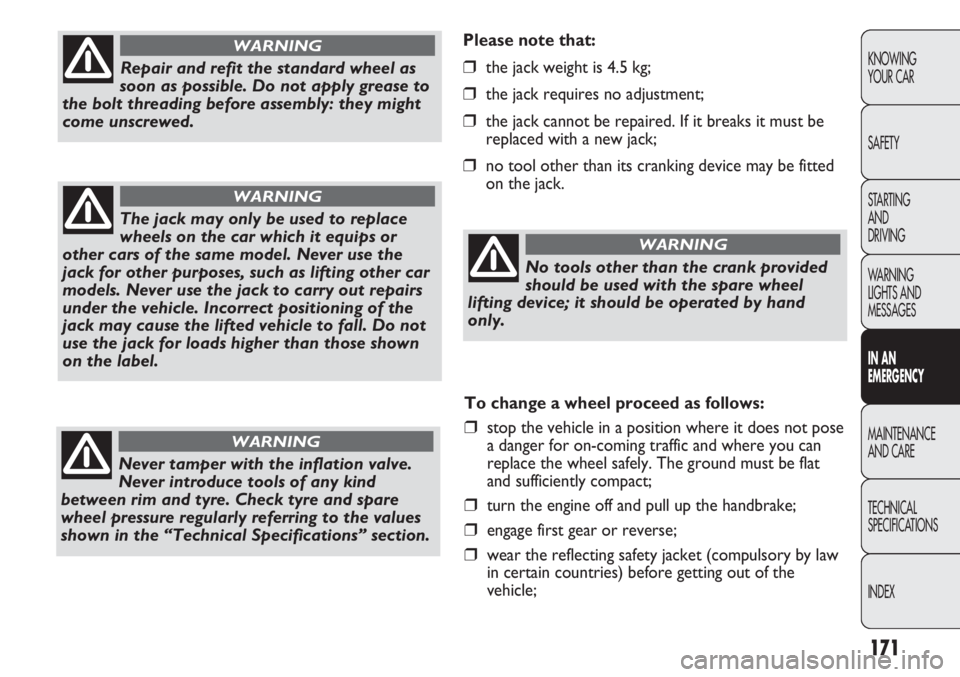
171
KNOWING
YOUR CAR
SAFETY
STARTING
AND
DRIVING
WARNING
LIGHTS AND
MESSAGES
IN AN
EMERGENCY
MAINTENANCE
AND CARE
TECHNICAL
SPECIFICATIONS
INDEX
Please note that:
❒the jack weight is 4.5 kg;
❒the jack requires no adjustment;
❒the jack cannot be repaired. If it breaks it must be
replaced with a new jack;
❒no tool other than its cranking device may be fitted
on the jack.
Repair and refit the standard wheel as
soon as possible. Do not apply grease to
the bolt threading before assembly: they might
come unscrewed.
WARNING
The jack may only be used to replace
wheels on the car which it equips or
other cars of the same model. Never use the
jack for other purposes, such as lifting other car
models. Never use the jack to carry out repairs
under the vehicle. Incorrect positioning of the
jack may cause the lifted vehicle to fall. Do not
use the jack for loads higher than those shown
on the label.
WARNING
Never tamper with the inflation valve.
Never introduce tools of any kind
between rim and tyre. Check tyre and spare
wheel pressure regularly referring to the values
shown in the “Technical Specifications” section.
WARNING
No tools other than the crank provided
should be used with the spare wheel
lifting device; it should be operated by hand
only.
WARNING
To change a wheel proceed as follows:
❒stop the vehicle in a position where it does not pose
a danger for on-coming traffic and where you can
replace the wheel safely. The ground must be flat
and sufficiently compact;
❒turn the engine off and pull up the handbrake;
❒engage first gear or reverse;
❒wear the reflecting safety jacket (compulsory by law
in certain countries) before getting out of the
vehicle;
Page 180 of 287
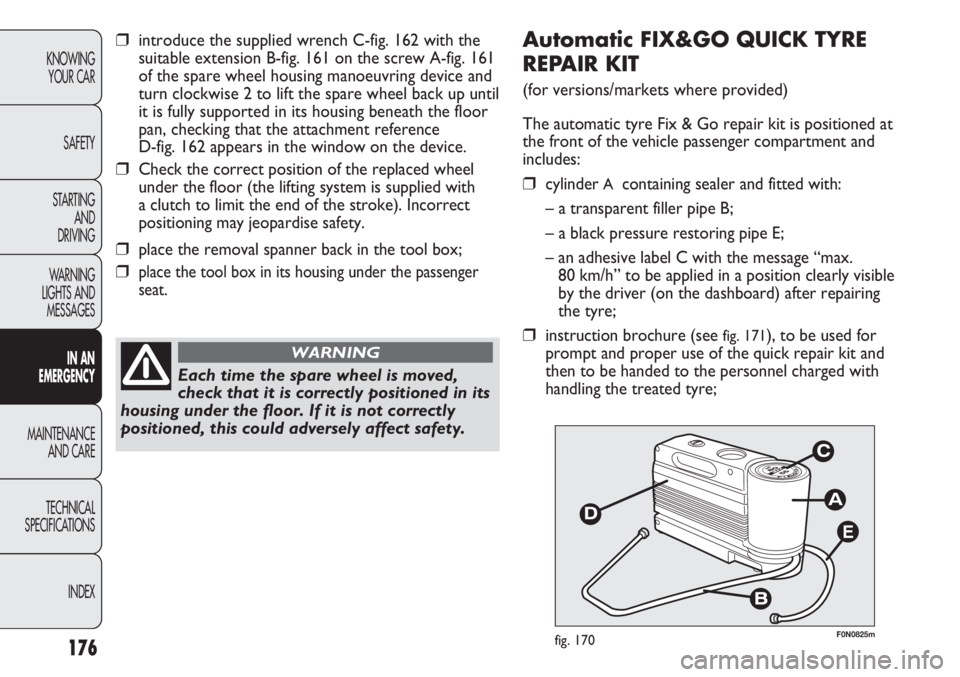
176
KNOWING
YOUR CAR
SAFETY
STARTING
AND
DRIVING
WARNING
LIGHTS AND
MESSAGES
IN AN
EMERGENCY
MAINTENANCE
AND CARE
TECHNICAL
SPECIFICATIONS
INDEX
E
F0N0825mfig. 170
Automatic FIX&GO QUICK TYRE
REPAIR KIT
(for versions/markets where provided)
The automatic tyre Fix & Go repair kit is positioned at
the front of the vehicle passenger compartment and
includes:
❒cylinder A containing sealer and fitted with:
– a transparent filler pipe B;
– a black pressure restoring pipe E;
– an adhesive label C with the message “max.
80 km/h” to be applied in a position clearly visible
by the driver (on the dashboard) after repairing
the tyre;
❒instruction brochure (see fig. 171), to be used for
prompt and proper use of the quick repair kit and
then to be handed to the personnel charged with
handling the treated tyre;
Each time the spare wheel is moved,
check that it is correctly positioned in its
housing under the floor. If it is not correctly
positioned, this could adversely affect safety.
WARNING
❒introduce the supplied wrench C-fig. 162 with the
suitable extension B-fig. 161 on the screw A-fig. 161
of the spare wheel housing manoeuvring device and
turn clockwise 2 to lift the spare wheel back up until
it is fully supported in its housing beneath the floor
pan, checking that the attachment reference
D-fig. 162 appears in the window on the device.
❒Check the correct position of the replaced wheel
under the floor (the lifting system is supplied with
a clutch to limit the end of the stroke). Incorrect
positioning may jeopardise safety.
❒place the removal spanner back in the tool box;
❒place the tool box in its housing under the passenger
seat.
Page 181 of 287
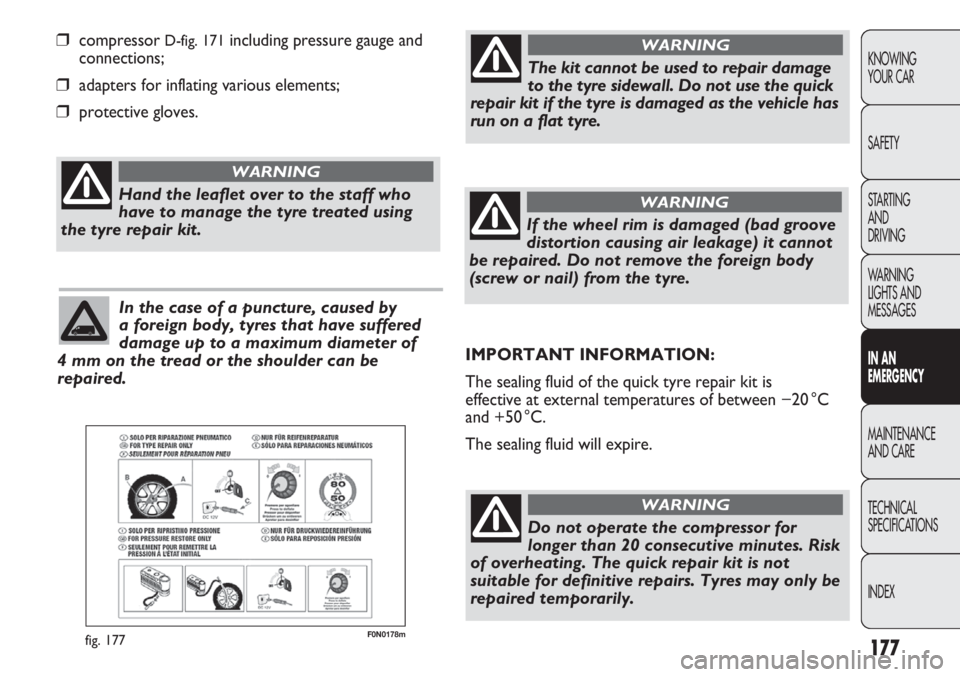
177
KNOWING
YOUR CAR
SAFETY
STARTING
AND
DRIVING
WARNING
LIGHTS AND
MESSAGES
IN AN
EMERGENCY
MAINTENANCE
AND CARE
TECHNICAL
SPECIFICATIONS
INDEX
F0N0178mfig. 177
❒compressor D-fig. 171including pressure gauge and
connections;
❒adapters for inflating various elements;
❒protective gloves.
Hand the leaflet over to the staff who
have to manage the tyre treated using
the tyre repair kit.
WARNING
In the case of a puncture, caused by
a foreign body, tyres that have suffered
damage up to a maximum diameter of
4 mm on the tread or the shoulder can be
repaired.
The kit cannot be used to repair damage
to the tyre sidewall. Do not use the quick
repair kit if the tyre is damaged as the vehicle has
run on a flat tyre.
WARNING
If the wheel rim is damaged (bad groove
distortion causing air leakage) it cannot
be repaired. Do not remove the foreign body
(screw or nail) from the tyre.
WARNING
IMPORTANT INFORMATION:
The sealing fluid of the quick tyre repair kit is
effective at external temperatures of between −20 °C
and +50 °C.
The sealing fluid will expire.
Do not operate the compressor for
longer than 20 consecutive minutes. Risk
of overheating. The quick repair kit is not
suitable for definitive repairs. Tyres may only be
repaired temporarily.
WARNING
Page 182 of 287
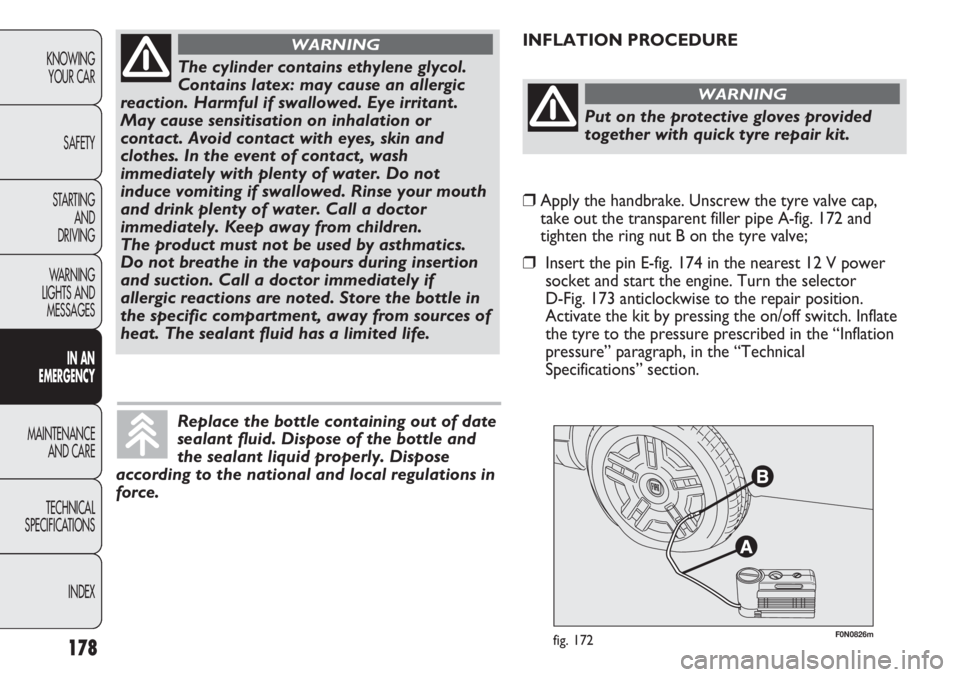
178
KNOWING
YOUR CAR
SAFETY
STARTING
AND
DRIVING
WARNING
LIGHTS AND
MESSAGES
IN AN
EMERGENCY
MAINTENANCE
AND CARE
TECHNICAL
SPECIFICATIONS
INDEX
F0N0826mfig. 172
INFLATION PROCEDURE
The cylinder contains ethylene glycol.
Contains latex: may cause an allergic
reaction. Harmful if swallowed. Eye irritant.
May cause sensitisation on inhalation or
contact. Avoid contact with eyes, skin and
clothes. In the event of contact, wash
immediately with plenty of water. Do not
induce vomiting if swallowed. Rinse your mouth
and drink plenty of water. Call a doctor
immediately. Keep away from children.
The product must not be used by asthmatics.
Do not breathe in the vapours during insertion
and suction. Call a doctor immediately if
allergic reactions are noted. Store the bottle in
the specific compartment, away from sources of
heat. The sealant fluid has a limited life.
WARNING
Replace the bottle containing out of date
sealant fluid. Dispose of the bottle and
the sealant liquid properly. Dispose
according to the national and local regulations in
force.
Put on the protective gloves provided
together with quick tyre repair kit.
WARNING
❒Apply the handbrake. Unscrew the tyre valve cap,
take out the transparent filler pipe A-fig. 172 and
tighten the ring nut B on the tyre valve;
❒Insert the pin E-fig. 174 in the nearest 12 V power
socket and start the engine. Turn the selector
D-Fig. 173 anticlockwise to the repair position.
Activate the kit by pressing the on/off switch. Inflate
the tyre to the pressure prescribed in the “Inflation
pressure” paragraph, in the “Technical
Specifications” section.
Page 183 of 287
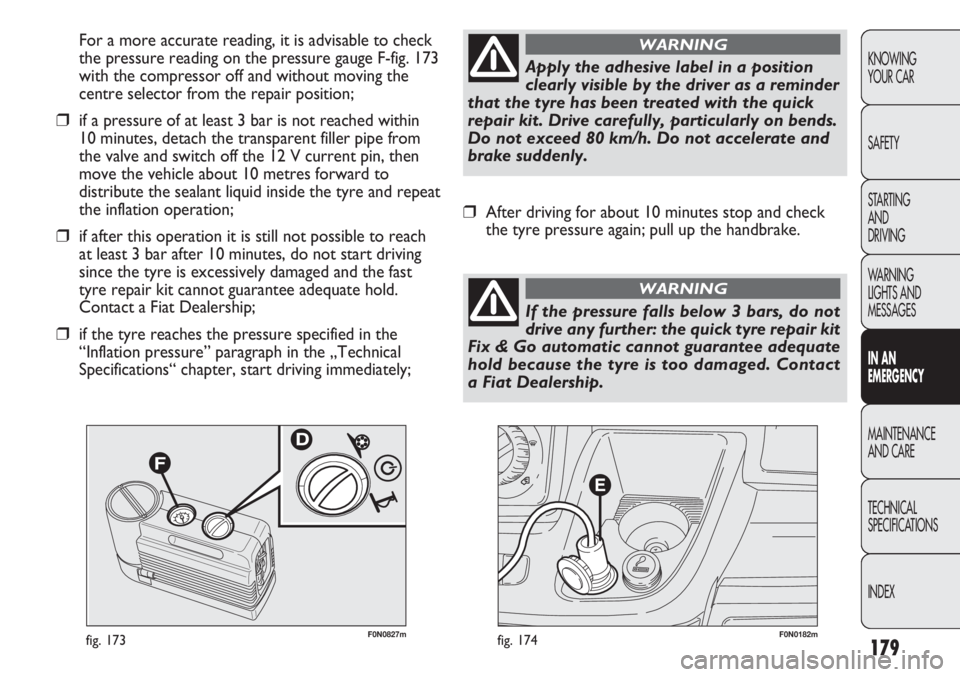
179
KNOWING
YOUR CAR
SAFETY
STARTING
AND
DRIVING
WARNING
LIGHTS AND
MESSAGES
IN AN
EMERGENCY
MAINTENANCE
AND CARE
TECHNICAL
SPECIFICATIONS
INDEX
F0N0182mfig. 174F0N0827mfig. 173
For a more accurate reading, it is advisable to check
the pressure reading on the pressure gauge F-fig. 173
with the compressor off and without moving the
centre selector from the repair position;
❒if a pressure of at least 3 bar is not reached within
10 minutes, detach the transparent filler pipe from
the valve and switch off the 12 V current pin, then
move the vehicle about 10 metres forward to
distribute the sealant liquid inside the tyre and repeat
the inflation operation;
❒if after this operation it is still not possible to reach
at least 3 bar after 10 minutes, do not start driving
since the tyre is excessively damaged and the fast
tyre repair kit cannot guarantee adequate hold.
Contact a Fiat Dealership;
❒if the tyre reaches the pressure specified in the
“Inflation pressure” paragraph in the „Technical
Specifications“ chapter, start driving immediately;
Apply the adhesive label in a position
clearly visible by the driver as a reminder
that the tyre has been treated with the quick
repair kit. Drive carefully, particularly on bends.
Do not exceed 80 km/h. Do not accelerate and
brake suddenly.
WARNING
❒After driving for about 10 minutes stop and check
the tyre pressure again; pull up the handbrake.
If the pressure falls below 3 bars, do not
drive any further: the quick tyre repair kit
Fix & Go automatic cannot guarantee adequate
hold because the tyre is too damaged. Contact
a Fiat Dealership.
WARNING
Page 184 of 287

180
KNOWING
YOUR CAR
SAFETY
STARTING
AND
DRIVING
WARNING
LIGHTS AND
MESSAGES
IN AN
EMERGENCY
MAINTENANCE
AND CARE
TECHNICAL
SPECIFICATIONS
INDEX
F0N0828mfig. 175
❒If at least 3 bar pressure is read, restore the correct
pressure specified in the paragraph „Inflation
pressure“ in the „Technical Specifications“ section
(with engine running and handbrake on) and restart.
❒drive with the utmost care to the nearest Fiat
Dealership.
You must inform the dealership that the
tyre has been repaired using the quick
tyre repair kit. Hand the leaflet over to the staff
who will be dealing with the the tyre treated
using the tyre repair kit.
WARNING
If different tyres from the ones supplied
with the vehicle are used, the repair
cannot be carried out. If the tyres are replaced,
it is advisable to use those approved by the
manufacturer. Contact a Fiat Dealership .
WARNING
❒Undo the cap for the tyre valve, extract the pipe
C-fig. 175 with the quick connector and connect it
directly to the valve of the tyre to be inflated.
❒Insert the pin in the nearest 12 V power socket and
start the engine.
❒Rotate the selector clockwise to the pressure
renewal position.
❒Activate the kit by pressing the on/off switch. Inflate
the tyre to the pressure specified in the „Inflation
pressure“ paragraph, in the „Technical Data“
chapter.
NOTE If the tyre has to be deflated, press the dedicated
button B illustrated in fig. 176. For a more accurate
reading, it is advisable to check the pressure reading on
the pressure gauge with the compressor off and without
moving the centre selector from the pressure restoring
position.
FOR CHECKING AND RESTORING
PRESSURE ONLY
The compressor can be also used solely for restoring
pressure.
❒Engage the handbrake